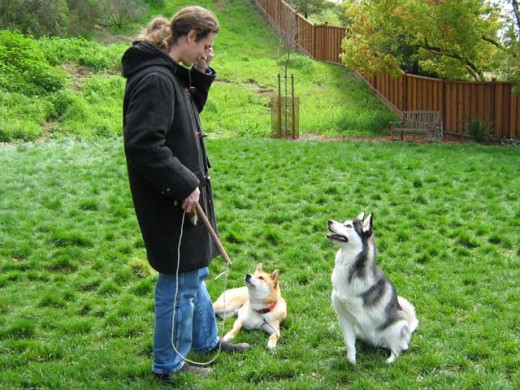Hi Shibashake.
I really enjoyed reading this, including all the comments. I also appreciate very much your inclusion of the Polski and Schalke studies. It is refreshing to see legitimate citations of actual controlled studies regarding a topic so incendiary as this one. I’m very curious as to why you didn’t find other studies, particularly the 1983 Tortora study, worth mentioning?
My 7yr old Bull Terrier has been my companion and my pride&joy for the past year. She is deaf, and she has some “instrumental” dog-aggression issues, as well as a prey-drive that can only be described as cartoonishly over-the-top. She doesn’t know the difference between a goat vs a cat vs a running valet vs a child on a tricycle vs a piece of trash blowing in the wind: if it looks like its running from her, she MUST get it… even straight into traffic. Deafness completely aside–there is no communicating with her when she goes into this “zone”. You may as well try to communicate with a cannonball en route.
I am concerned about her stress levels, and after reading your blog I am keenly aware of how difficult it must be to apply shock-training competently. I am also keenly aware of the unnecessary stress created by these behaviors (it is nerve-racking for her AND me). I’m trying to decide which outweighs the other. Her aggression issues seem to be diminishing over time as I learn more about pack-dynamics, but the intensity of the prey drive and tunnel-vision focus that accompany it remain overpowering.
After a year of deliberating, reading, and weeding out the namby-pamby appeals to emotion (“poor, poor dogs, evil, evil humans”) as well as the neanderthalic appeals to cowboy-complexes (“gotta show the dog who’s boss!”) I have decided that the vibration-signal feature is a must for us, but I’m still open to rational discourse regarding the shock feature. I would love to hear your thoughts on the Tortora study 🙂
~~[RUFTY]
Tortora’s 1983 Study
Tortora’s 1983 study consists of 3 experiments. The one most talked about in shock collar discussions is the “safety training” experiment (Exp 2). Some proponents of shock collars use Tortora’s study to claim that electronic collars are effective at reducing general aggression in dogs.
Based on my reading of Tortora’s paper, these claims are false. I will explain why below.
Tortora’s “safety training” experiment (Exp 2) consists of three phases:
Phase 1 – Pre-testing and Pre-training
36 dogs with avoidance motivated aggression were trained to perform 15 basic obedience commands using regular techniques. Training started with a continuous schedule of reinforcement, then moved on to variable. Both play and choke collars were used. No shocks.
Phase 2 – Conditioning
After a command was given, a warning buzz is presented, then the electrical stimulus is delivered. When a dog performs the command (correct escape behavior), a safety signal or tone was used right before the electrical stimulus was turned off.
Training of commands was conducted in progressively more challenging conditions, and the level of electrical stimulus was also increased during the training process. Ultimately, the dogs were trained to tolerate and perform under high levels of electrical stimulus. Once that was achieved, the dogs were trained without the shocks.
Phase 3 – Normalization
Subjects were tested for the absence of aggression under maximally stressful and aggression-inducing circumstances, for example, while the animal was roughly handled and beaten about the body with a rolled-up newspaper or switch.
If the dog failed to perform the command or responded with aggression then a full intensity electrical stimulus was delivered. Finally, the electrical stimulus was slowly phased out and training was transferred to the owner’s home.
Tortora reported that this procedure “resulted in complete and permanent elimination of aggression in all of the 36 dogs tested”. Note that this study specifically addresses cases of avoidance-motivated-aggression, which is different from pain elicited aggression and fear motivated aggression.
Tortora also showed (in Exp 1) that these other types of aggression and problem behaviors can be effectively addressed with established counter-conditioning techniques, and does not require such extreme measures.

What Is Avoidance Motivated Aggression?
It is important to note that Tortora’s experiment 2 deals specifically with avoidance motivated aggression. Therefore, we should understand exactly what avoidance motivated aggression is, and how it differs from other types of aggression.
Avoidance motivated aggression is an aversively motivated aggression in dogs. I.e. the dog is using aggression as a means to avoid an anticipated aversive event (e.g. expectation of pain).
Avoidance-motivated aggression in dogs involves biting attacks or threats of attack directed toward one or more of the dog’s human caretakers. As the name implies, these threats and bites are assumed to be avoidance responses that are acquired and maintained by the prevention of anticipated aversive events.
~~[Tortora 1983, pp176]
Some properties of avoidance motivated aggression that differentiate it from other aversively motivated aggression:
- It can appear to be unpredictable.
Through higher order conditioning and generalization, a variety of apparently neutral and unrelated stimuli come to elicit the avoidance response of aggression.
- The dog does not produce any signals that may indicate the onset of aggression.
- It produces a much more serious attack than the other forms of aggression.
Avoidance-motivated aggression usually involves multiple bites, a sustained attack, and is not self-terminating.
- Avoidance-motivated aggression develops over time and there is a clear escalation in the level of aggression as it develops. The aggressive episodes increase in duration, frequency, force/damage, and occur over a larger range of stimuli. I.e., there are many chances to fix the issue before it develops into an “instrumental avoidance response”.
- Counter conditioning techniques that are effective with other forms of aversively motivated aggression, have little effect on avoidance motivated aggression.
Tortora’s safety training is a complex 9 stage process that specifically addresses avoidance motivated aggression. Safety training using shock collars is very different from aversion therapy or aversive training using shock collars. Aversive training is how shock collars are commonly used today, i.e. shock the dog when he is performs an undesirable behavior. Continue delivering the shock until he stops that behavior.
In Exp 3, Tortora showed that when only “full-intensity signaled shock was used to punish aggression”, there was only a slight decrease in aggression. I.e., shock aversion therapy or simple shock aversive training is not an effective way to suppress aggression in our dogs.

Key Points from Tortora’s 1983 Study
Some salient points I derived from Tortora’s paper:
1. Timing and clear communication
Timing and clear communication are very important, especially in pain based aversive training. This was shown in Phase 2 where Tortora used a warning buzz and conditioned the dog to a safety signal. Using a unique tone also allows us to more consistently and accurately mark a behavior in time (the same type of thing is used in clicker training).
Accurate timing and clear communication is important because it lets the dog know how to stop or avoid the pain from an electrical stimulus. This was also shown in Schalke’s study, where the dogs that could make a clear association, i.e. knew how to stop the pain, did not experience elevated stress levels. This only occurred in the very simple aversion case and not on recall.
This is also why aversive techniques are risky because most of us, especially novice trainers, have far from perfect timing, and may not always communicate with our dogs in a precise and clear manner.
2. Pain is a strong but risky motivator
Using pain can produce more reliable compliance in our dogs, because pain is a strong motivator. However, pain and stress can elicit an aggressive reaction from our dogs. This was also present in Tortora’s study. In fact, in Exp 1, Tortora reports that of the 92 avoidance motivated aggression cases, 90% had prior pain based aversive experiences.
The dogs in this study initially behaved as if they “expected” aversive events and that the only way to prevent these events was through aggression.
3. Tortora’s experiment 2 is a very extreme and specialized process
Dogs can also get habituated to the pain, and subsequently require a stronger and stronger stimulus. For example, Tortora reported increasing the electrical stimulus to high and ultimately maximum levels during the study.
Avoidance motivated aggression can be suppressed with avoidance training and the use of full intensity shocks.

Conclusion
I am not sure why Tortora’s study is used to make the case for electronic collars or shock collars. As I understand it, his work is targeted at “dangerously aggressive dogs”, in particular those that did not respond to “established counter-conditioning treatments”, i.e., only cases of avoidance motivated aggression. It is clear that his procedure is very extreme, requires a lot of precision and knowledge, and is only meant for very limited situations. If anything, it is a cautionary tale of what could happen if we fail our dog in his management, care, and training.
Tortora shows that pain and stress can cause aggression (which is consistent with other studies), and that avoidance motivated aggression can be suppressed with avoidance training and full intensity shocks. To me, this underscores the risks of using pain based aversive techniques, and inadvertently creating a “dangerously aggressive dog”, who then has to undergo even more extreme treatment or face euthanasia. Tortora states
Behavior therapy for such dogs has always been the last step before euthanasia.
…
In conclusion, it should be emphasized that safety training for dogs is not being recommended literally as a behavior therapy program for avoidance-motivated human psychopathologies. A substitute for electrical stimulation may have to be found.
If you are considering using shock collars because of Tortora’s study, please read it carefully and in full first. Unfortunately, inaccurate claims abound on the internet.

Hi, thank you for this article, very helpful! How do you feel about using E-collars not as punishment but on a very low (or vibrate setting) to get your dog’s attention when outside and very distracted… instead of screaming their name when they’re a bit further away. I’m trying to work on recall at further distances (e.g. 20+ feet) and sometimes I can’t get my husky to look at me to even receive the “come” command. From what I’ve read, the idea would be to 1) gently buzz the collar 2) issue the command 3) reward compliance, with praise/treat
What do you think of that approach? Have you seen any studies that have tested this method?
Thanks again!
Hi Shibashake, how lovely to come across the website of another fellow Husky and Shiba owner. I will take time to browse more of your website! Please check my instagram account! https://www.instagram.com/sarita.nanuk.yoshi/
Sarita
Oh my! Totally adorable! Thank you for sharing. 🙂
Hi,
I have been searching for a Shiba for over a year now and I still haven’t found a breeder that is responsible and honest about their puppy breeding conditions. Recently I found this breeder that has been using images posted on your website and claimed that they were the dog parents of their puppies. I am not sure what to do. I will not buy dogs from this breeder but I thought you should know.
Excellent article!
Shock collars, like a lot of other “correctional” devices (e.g. choke, prong, or triple crown collars), are simply torture for our beloved four legged companions. Positive reinforcement techniques will always be more successful than physical punishement.
I enjoy reading your writing. There’s lots of great info. You mentioned elsewhere that you read lots of books and watched lots of videos. I’m likely going to be a first time Shiba Inu pack leader. (I had a dalmatian as a kid-barely counts towards claimable experience, I suppose.) Anyway, I was wondering if you would suggest any reading or online material for me–maybe something systematic or at least with a good outline? It’s already been recommended to me to read “Training the Best Dog Ever” by Dawn Sylvia-Staslewicz, and I’ve read it. I’m still confused about what to do at what age with a puppy. That book would work great if I was getting an adult dog.
Thanks!
Bart
Oh, and I forgot to say that I love your dogs and I love how honestly you write about them. Thanks.
Zac George’s training revolution book and youtube page are pretty helpful I find
i love this articale leave me some info on it.
Hi i would like to know how can i cite you..
Thanks!
Hi. My puppy is a cocker spaniel fast approaching her 16th birthday. She has had anxiety issues all her life and I wish I had found you sooner because many of your suggestions would have helped us…but now here she is getting snippier and harder to manage. Grooming is an enormous issue. Is there anything I can do in preparation which might help her get through this? Normally she sleeps and eats and does her thing. She is a unique situation where I can’t control her surroundings.
Thank you!
Hi, I experienced my normally sweet lab mix becoming aggressive at 15 and finally realized he had arthritis. Aqua therapy helped quite a lot. Also, older dogs can become more snippy due to vision/hearing loss.